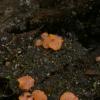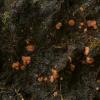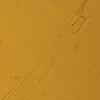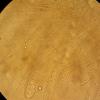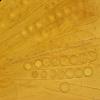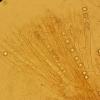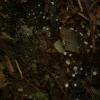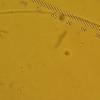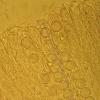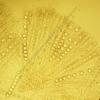
26-11-2025 18:13
The entire run of Mycotaxon is now available throu

25-11-2025 14:24
Thomas Læssøehttps://svampe.databasen.org/observations/10490522

25-11-2025 11:03
Mick PeerdemanHi all,One of my earliest microscopy attempts, so

24-11-2025 15:23
Arnold BüschlenHallo, auf einer offenen Kiesfläche am Rande ein

23-11-2025 11:16
Bohan JiaHi, I found small discs growing on dead stem of

21-11-2025 10:56
 Christopher Engelhardt
Christopher Engelhardt
Very small (~0,5 mm) white ascos, found yesterday
Salmon Pulvinula
Zuzana Sochorová (Egertová),
20-07-2014 13:43
 Bonjour,
Bonjour,this Pulvinula is from Georgia - Batumi botanical garden, Transcaucasian section. It grew in a flowerbed on a wet ground with pieces of wood, together with Peziza michelii. Collected on 6th July 2014.
Apothecia 0,5-4,5 mm broad, sessile, pink-salmon, sometimes with yellow tinge, rounded or irregularly shaped, flat or slightly convex.
Spores globose, 10,5-13 micrometers, smooth, hyaline.
Asci cylindric, 195-220 x 9,5-13,5 micrometers, with 8 spores, no reaction in Lugol.
Paraphyses about 1,5 micrometer broad, curved, with orange granules.
Pulvinula laeterubra seems to be the most similar species, but asci of my Pulvinula are longer then given by Pfister - (140)-161-184-(200) micrometers.
Zuzana
Gilbert MOYNE,
20-07-2014 14:28
Re : Salmon Pulvinula
Paraphyses divisées au sommet pour P. laeterubra... sinon, regarder du côté de Pulvina globifera...
Gilbert
Gilbert
Zuzana Sochorová (Egertová),
20-07-2014 15:25

Re : Salmon Pulvinula
Merci Gilbert.
I have got one more Pulvinula from Georgia (from a different part of the country - Racha mountains) and it´s true it´s very similar to Pulvinula from Batumi microscopically, although totally different macroscopically.
These were white, up to 1 mm broad and grew together with Rhodoscypha ovilla. Unfortunatelly I didn´t find free spores, the biggest spores inside the asci measure 11-13 micrometers and have got 1 big guttule. Asci are 188-212 x 10,5-13 micrometers, contain 8 spores. Paraphyses are 1,2-1,5 micrometers broad, curved, not branched at apex. 8 spores in asci exclude P. lacteoalba, apothecia are too small for P. albida, spore size is too small for P. alba, asci are too short for P. niveoalba (and its spores should contain many small guttules)... so I think Pulvinula from Racha mountains should be P. globifera. Then you are probably right with globifera from Batumi... thank you.
Zuzana
I have got one more Pulvinula from Georgia (from a different part of the country - Racha mountains) and it´s true it´s very similar to Pulvinula from Batumi microscopically, although totally different macroscopically.
These were white, up to 1 mm broad and grew together with Rhodoscypha ovilla. Unfortunatelly I didn´t find free spores, the biggest spores inside the asci measure 11-13 micrometers and have got 1 big guttule. Asci are 188-212 x 10,5-13 micrometers, contain 8 spores. Paraphyses are 1,2-1,5 micrometers broad, curved, not branched at apex. 8 spores in asci exclude P. lacteoalba, apothecia are too small for P. albida, spore size is too small for P. alba, asci are too short for P. niveoalba (and its spores should contain many small guttules)... so I think Pulvinula from Racha mountains should be P. globifera. Then you are probably right with globifera from Batumi... thank you.
Zuzana
René Dougoud,
21-07-2014 10:49
Re : Salmon Pulvinula
Chère Zuzana,
Pfister (1976) - Synopsis of the genus Pulvilula, in Occasional papers of the Farlow Herbarium 9, indique que P. lacteoalba J. Moravec et probablement une forme tetrasporique de P. globifera (Berk & Curt.) Le Gal.
Amicalement
René
Pfister (1976) - Synopsis of the genus Pulvilula, in Occasional papers of the Farlow Herbarium 9, indique que P. lacteoalba J. Moravec et probablement une forme tetrasporique de P. globifera (Berk & Curt.) Le Gal.
Amicalement
René
Zuzana Sochorová (Egertová),
21-07-2014 11:11

Re : Salmon Pulvinula
Merci René. I read this comment in the Pfister´s article at Cyberliber, but there is P. lacteoalba in your key (which is much newer then Pfister´s work), so I didn´t know what is the recent view on this.
However, I´m unsure about the identity of my fungus again, because Marcel wrote me Pulvinula globifera was considered to be a tropical species. I didn´t know this fact because this species was included in Pilze der Schweiz.
On the other side, the locality of the salmon Pulvinula is a botanical garden and I think strange fungi can grow there...
Z.
However, I´m unsure about the identity of my fungus again, because Marcel wrote me Pulvinula globifera was considered to be a tropical species. I didn´t know this fact because this species was included in Pilze der Schweiz.
On the other side, the locality of the salmon Pulvinula is a botanical garden and I think strange fungi can grow there...
Z.


